When people who own gear priced in the thousands of dollars encounter similar gear priced in the hundreds of dollars, human nature practically forces them to disparage the cheap stuff. So I wasn’t surprised to see a few professionals disparaging the new miniDSP EARS headphone measurement jig on social media. I chimed in myself, predicting that the EARS might be part of an ongoing “crisis in headphone measurement.”
The EARS costs just $199 USD. The next-least-expensive headphone measurement rig I’ve seen, the G.R.A.S. 43AG I own, runs somewhere around $7500 if you get the latest options. (That’s my educated guess; G.R.A.S. doesn’t publish prices.) The G.R.A.S. 43AG conforms to IEC 60268-7, the current international standard for headphone measurements, while the EARS doesn’t seem to conform to any standard.
But does it really matter? I know a few headphone designers who dispute the utility of the standardized headphone measurement gear now in use. They prefer simpler, home-grown measurement setups, often a standard measurement microphone installed in a flat plate.
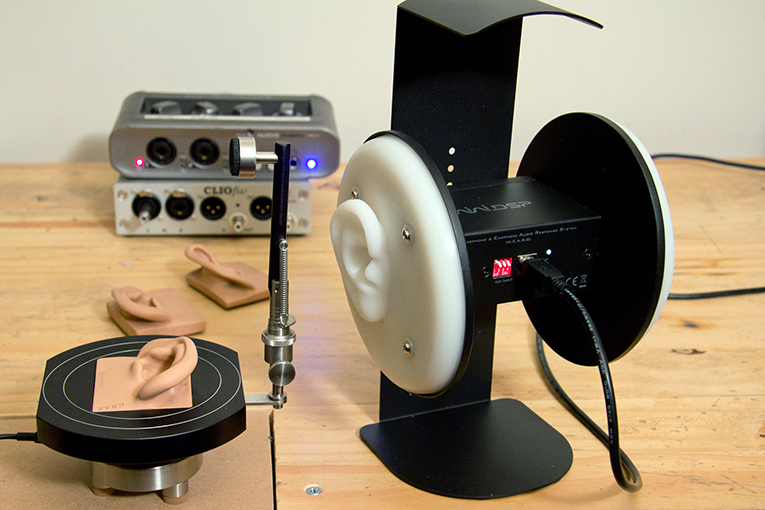 The G.R.A.S. Model 43AG (left) and miniDSP EARS (right) setups
The G.R.A.S. Model 43AG (left) and miniDSP EARS (right) setups
The miniDSP EARS is intended primarily for use with miniDSP’s HA-DSP, which has an internal digital signal processor that can be used for EQing headphones to a desired response, but I have to think the company knew that use of the EARS might go far beyond that. While the EARS manual cautions users to “Please note that EARS is not an industry-standard measurement head,” miniDSP states on the website that “EARS brings headphone measurement capability to ‘the masses’.” So they’re not exactly positioning the EARS as a substitute for standardized gear, but as I expected, at least a couple of headphone reviewers have already bought the EARS and started using it for measurements in reviews.
There’s no question that the 43AG has much more engineering and manufacturing cost built into it. It incorporates an ear simulator engineered with IEC-compliant resonating chambers that mimic the acoustical properties of the average human ear, and it uses simulated pinnae modeled on a couple of different average human earlobe shapes. The EARS, on the other hand, is just a couple of inexpensive electret condenser microphone capsules attached to molded pinnae that, while obviously similar to human earlobes, have a thick, meaty, stiff feel, as if they were modeled on the earlobes of heavyweight boxers who’ve spent too many years in the ring. It has no simulated ear canals, just straight tubes molded into the pinnae, and there’s no way to affix an industry-standard calibrator to set and check levels. (The microphones themselves are calibrated, so you can set levels, although you can’t easily check them against a reference.)
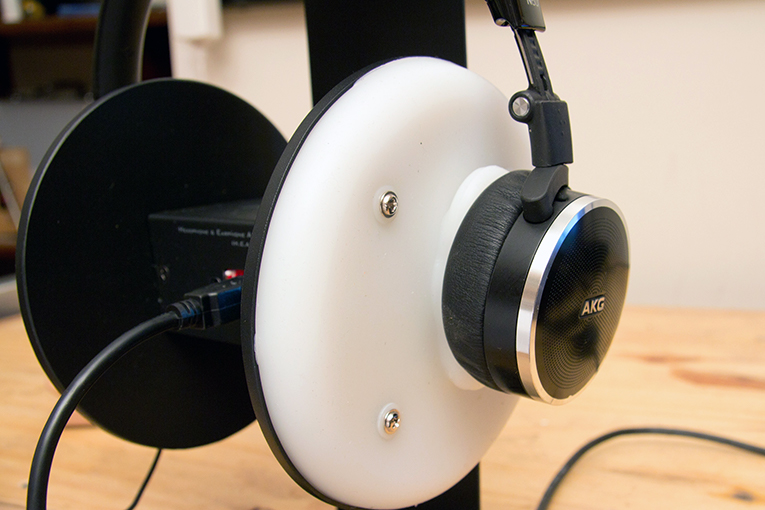 The stiff, thick simulated pinnae on the EARS make it difficult to get a good seal with on-ear headphones such as the AKG N60 NCs.
The stiff, thick simulated pinnae on the EARS make it difficult to get a good seal with on-ear headphones such as the AKG N60 NCs.
One advantage over the 43AG is that the EARS incorporates simulated left and right ears, whereas the 43AG can measure only one side at a time, using simulated left and right pinnae that fit into the fixture. An industry-standard ear simulator with left and right ears starts at about $12,000.
So . . . $200 versus $7500? Could the 43AG really be worth nearly 40 times the price of the EARS? The only way I could know for sure was to buy the EARS and try it for myself.
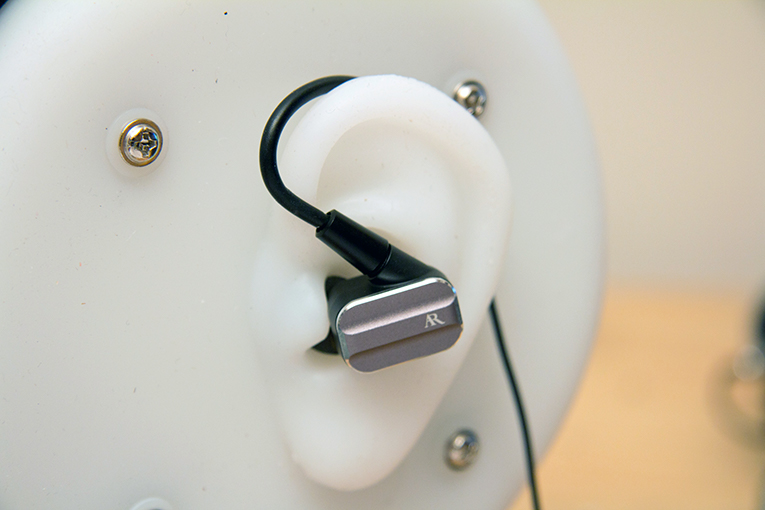 An Acoustic Research AR-E010 earphone mounted in the EARS
An Acoustic Research AR-E010 earphone mounted in the EARS
Using your EARS
The EARS has USB output only, so it’s designed to connect to computers, and thus to work with measurement software such as Room EQ Wizard and TrueRTA. Interfacing it with a typical outboard audio analyzer, such as the Audiomatica Clio 10 FW I use, requires passing the EARS signal through the computer and sending it out to the analyzer through the computer’s analog outputs, or through a USB interface. I was able to get this to work, but it introduced latency and seemed to add some noise, so I decided to stick with Room EQ Wizard for my EARS evaluation. In fact, the instructions in the EARS manual -- a thoughtful and informed document that’s far more useful than the perfunctory documentation accompanying some pro-level measurement gear -- assume you will use REW, and explain in detail how to configure REW for the EARS.
The microphones inside each EARS pinna are individually calibrated, and you can download the files for free. You can get the straight microphone calibration files, or calibration files with compensation curves included. Here’s what’s offered:
HEQ: This allows users to EQ headphones for subjectively flat response, although the target curve for that flat response is not specified, and the manual stresses that the user must choose an EQ curve based on what sounds right to them.
HPN: Same as above, but with a somewhat different target curve.
IDF: Diffuse-field compensation for earphones. This uses the industry-standard (although recently disputed) diffuse-field compensation curve for earphones.
RAW: Microphone calibration curves only, with no compensation.
For my tests with headphones, I mostly used the RAW calibration curves only, because my goal was to test the fixture, not the compensation curves. (Any compensation curve can be used with any software and any fixture.) If you’d like to see more extensive testing of the target curves used with the HA-DSP amp and a variety of headphones and earphones, let me know in the comments section below. I did use the IDF calibration, along with the RAW calibration, to test earphones.
How the curves compare
I decided to try the EARS with four different types of headphones: a standard over-ear model (Sony MDR-7506); a large, high-end over-ear model (HiFiMan HE1000 V2); an earphone (Campfire Comet); and an on-ear model (AKG N60 NC). I measured each of them using the EARS and my G.R.A.S. Model 43AG (using G.R.A.S.’s RA0402 ear simulator and KB5000 simulated pinna). In every case, I did as I always do, running multiple frequency response tests until I settled on what seems to be the most typical response of the headphones on that test fixture.
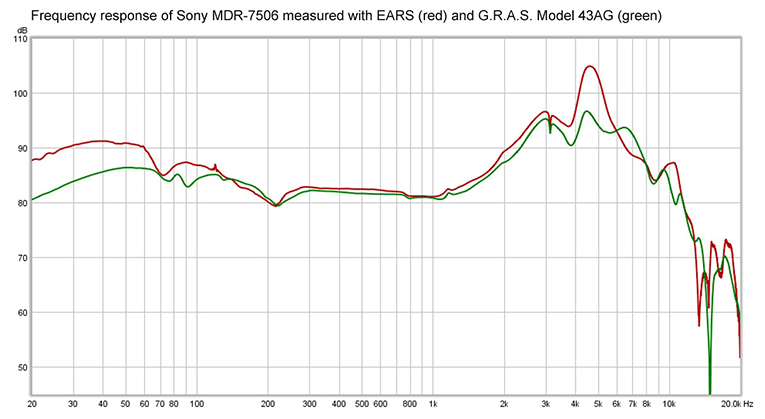
I first tried the EARS with Sony’s MDR-7506 headphones, because they’re something of an industry standard and their response is close to the so-called Harman curve, which is gaining acceptance as a suitable target response for over-ear headphones. When I ran my first measurement of the MDR-7506es with the EARS, I thought “yep, looks like 7506es” -- and that’s a good thing, because even though the graphs of Room EQ Wizard and the Clio 10 FW look different, the basic characteristics of the MDR-7506es’ response were evident.
There were some differences, though. The EARS show a much stronger peak (roughly +8dB) at 4.5kHz, relative to the Model 43AG. Also, the EARS show 1 to 2dB more average output in the treble, and 4 to 8dB more average output in the bass -- but those differences are extremely sensitive to the position of the headphone on the test fixture, especially in the bass. I could have gotten similar disparities simply by moving the headphone around on the Model 43AG.
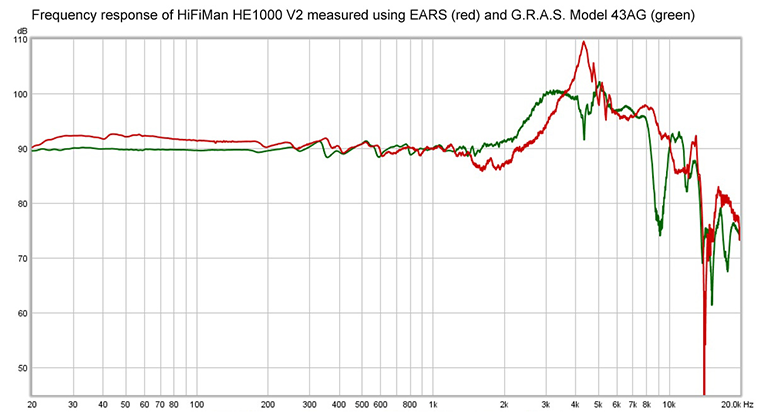
I then switched to the HiFiMan HE1000 V2s, mostly because I wanted to see how larger headphones would work on the EARS. In the above graph, we can see that the differences between the EARS and the Model 43AG were similar in ways to the differences we saw with the MDR-7506es. With the EARS, there’s strong peak centered at 4.2kHz, while the Model 43AG shows a dip. (These narrow, high-Q peaks and dips are very position-dependent.) Again we see an increase in average bass response with the EARS (although the magnitude of the increase is much smaller this time), but we also see a reduction in average upper-midrange/lower-treble response with the EARS, typically -3 to -4dB between 1.4 and 3.5kHz.
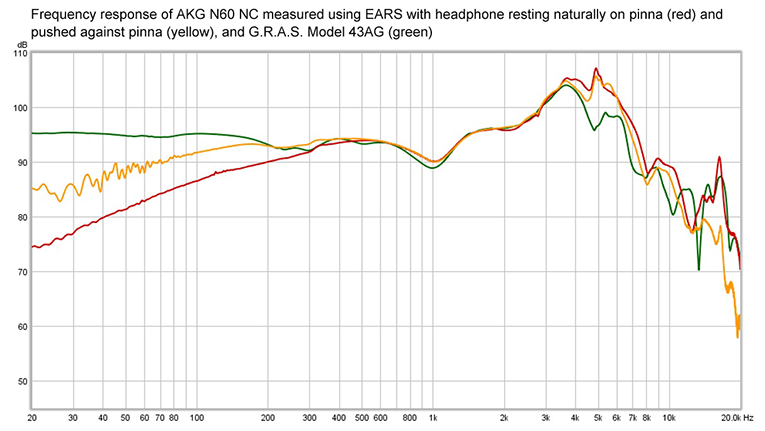
With on-ear headphones such as the AKG N60 NCs, the stiffness and thickness of the EARS’ simulated pinnae starts to become a problem. The curves are mostly close, although again we see stronger measured treble response in the 4 to 6kHz region with the EARS. Where we see the big difference is in the bass response, which is highly dependent on the seal of the headphones’ earpads on the simulated pinnae. The N60 NCs can’t seal as well with the stiff pinnae on the EARS, so the measurement shows a feeble bass response that’s down 20dB relative to the measurement with the Model 43AG. I tried pushing against the headphones’ earpiece with my hand to get a more realistic bass response measurement, but it helped only a little. (The squiggles you see in the yellow trace are noise, probably caused by vibrations from my hand.)
Incidentally, the measurement with the Model 43AG was taken without using the fixture’s spring-loaded clamping mechanism. With most on-ears, I measure by experimenting to get the best possible seal, then applying the clamping mechanism to seat the earpads firmly on the simulated pinna, then flipping the clamp back up. This seems to give me the result that most accurately reflects the perceived bass response of most of the on-ear headphones I’ve measured.
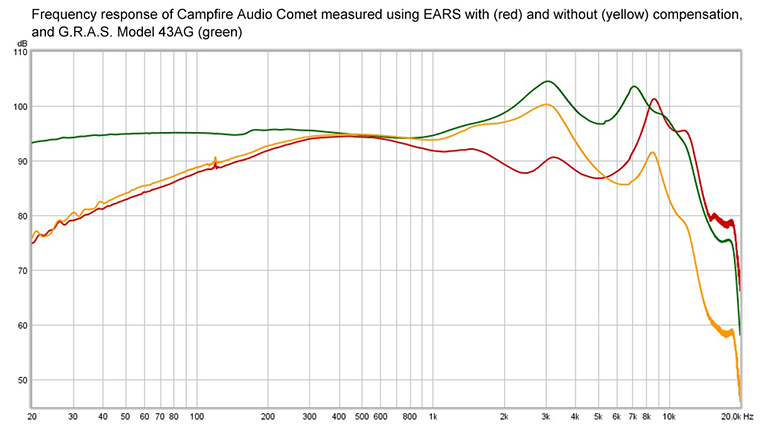
The acoustic interface between the EARS and earphones such as the Campfire Comets is even more questionable. Not only are the simulated pinnae unnaturally stiff, but they terminate in a straight, round hole measuring about 6mm in diameter and 12mm deep. This is an extremely crude simulation (if it even deserves that designation) of a human ear canal, so the fit of earphones won’t be natural.
To be fair, though, the fit of earphones in the KB0065 pinna originally included with the Model 43AG wasn’t natural, either -- it, too, terminated in a round hole, although the round hole covered an RA0045 ear simulator, which mimics the acoustical response of the average human ear. Until the new KB5000 anthropomorphic pinna was released last year, I had to measure earphones using the RA0045 and a conical, stainless-steel coupler, which, while it made it simple to get a good seal with most earphones, also didn’t present a realistic simulation of the shape of a human ear canal. And while the KB5000 is a wonderfully useful upgrade to the Model 43AG, you can buy about four EARS setups for the price of one KB5000.
I measured the Campfire Comets using EARS with the IDF compensation curve and without. Not surprisingly, the IDF measurement looks far different from the uncompensated Model 43AG measurement. However, by using the EARS with microphone compensation only, and excluding the diffuse-field compensation, I got a curve that somewhat resembles the Model 43AG curve, although it shows substantially less average bass and treble energy.
Judging the EARS
The differences in measured frequency response curves between the EARS and the Model 43AG are significant. So, though, are the differences between the Model 43AG with the KB0065 and KB5000 pinnae, which you can see from the headphone measurements we’ve published in the last year. Most of the other manufacturers of headphone-measurement gear have introduced their own anthropomorphic pinnae, and also introduced new ear simulators (such as the G.R.A.S. RA0402 I now use) that provide more useful results at frequencies higher than 8kHz. These are all welcome improvements, but they produce different measured results than we got with the older gear. The fact is, with headphones and earphones, we don’t have a clear reference for what constitutes a “correct” measurement.
With speakers, we do have a clear reference for accurate measurements: a calibrated anechoic chamber, something most large audio manufacturers possess, which is used for the speaker measurements on the SoundStage! sites. If a measurement that purports to capture the frequency response of the speaker alone (not the response of the speaker in a room) deviates from anechoic response measurements, it’s wrong. If a speaker’s anechoic response shows significant deviation from flat on-axis and gradually, smoothly rolled-off off-axis response, we know that speaker will have audible colorations. It doesn’t take much expertise to evaluate these curves; if it deviates much from flat, there’s an issue.
With headphones, we can’t be so sure. Even industry-standard fixtures produce frequency response measurements with large peaks and dips that can be interpreted only with considerable expertise, and through comparisons with other headphones or a standardized target curve, such as diffuse-field or the Harman curve. Even after measuring headphones and earphones for seven years now, I’m careful about judging them from the response curves.
What worries me is that many of the people who spend $199 for an EARS (which for audio enthusiasts counts as an impulse buy) won’t be so careful. I’ve already seen one EARS-owning reviewer state on Facebook that “there are no standards” for headphone measurement, even though those standards have been in place for decades. I know from 29 years of experience in editing audio product reviews that extremely few reviewers dig deep into the research that’s been done on the product categories they’re reviewing. Are the same people who buy the EARS going to take the time to read the IEC 60268-7 document that stands as the current reference for headphone testing -- especially considering that the current $281 price for a PDF of that document is more than the price of the EARS? I doubt it.
Personally, I can’t get much use out of something like the EARS, and no serious reviewer can, either. If we want to have enough credibility to raise concerns when we find anomalies in our measurements, we must be able to compare our results with those of manufacturers and researchers. To be a part of the “measurement community” -- audio professionals around the world who develop and conduct audio measurements, regularly attend technical conventions and seminars, and collaborate frequently, even with competitors -- we have to have measurement gear built to professional standards.
Considering the unpredictability of the results with the EARS with earphones and on-ear headphones, I certainly wouldn’t judge the performance of those products based on measurements taken with the EARS.
With over-ear headphones, though, I’d be more forgiving. A careful, diligent reviewer who takes the time to understand what the measurements mean could, I think, produce useful frequency response measurements of over-ear headphones using the EARS -- provided they present a comparison of those measurements with measurements of other headphones (especially well-known references such as the Sony MDR-7506es, or maybe the Sennheiser HD 650s) taken under the same conditions. To me, it’s akin to making in-room speaker measurements -- it’s never as useful or as accurate as doing anechoic or quasi-anechoic measurements, but if you know what you’re doing, you can get meaningful measurements with just a couple hundred dollars’ worth of gear.
As I see it, the “killer app” for the EARS is for over-ear headphone DIYers who physically modify their headphones in pursuit of better sound. With the EARS, they can easily (and, I think, accurately) gauge the results of their modifications relative to the unmodified version, thus saving themselves many hours of trial and error, and almost certainly achieving better end results.
The EARS would also be useful for gauging the effects of EQ changes when using the HA-DSP or other EQ-equipped devices or software. Of course, whether or not those EQ changes are a good idea ultimately has to be determined through listening, but maybe by using the EARS, you can figure out what kind of response you like and derive EQ curves that replicate that response with other headphones you own.
Only time will tell how people use (and abuse) the EARS, but overall, I think it’s a positive development. The evaluation of consumer audio products is a field that’s packed with opinions but mostly bereft of science and technical understanding. Despite the EARS’ flaws and deviations from professional standards, I’m optimistic that they’ll make it possible for headphone enthusiasts to attain a richer understanding of their hobby -- and there’s no way that can’t be a good thing.
. . . Brent Butterworth





